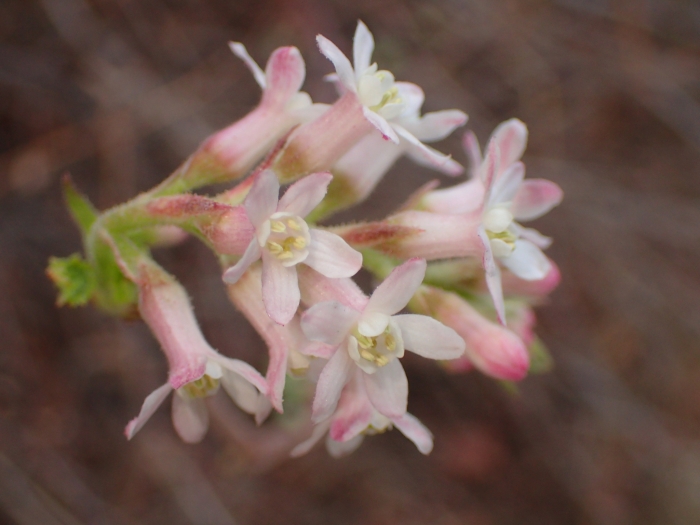Chaparral Currant
(Ribes malvaceum)
Chaparral Currant (Ribes malvaceum)
/
/

George Williams
CC BY 4.0
Image By:
George Williams
Recorded By:
Copyright:
CC BY 4.0
Copyright Notice:
Photo by: George Williams | License Type: CC BY 4.0 | License URL: http://creativecommons.org/licenses/by/4.0/ | Rights Holder: George Williams | Publisher: iNaturalist | Date Created: 2021-01-12T10:49:07-08:00 |





















































Estimated Native Range
Summary
Ribes malvaceum, commonly known as Chaparral Currant, is a deciduous shrub native to the chaparral and mixed evergreen forests of California and Northwestern Mexico. It typically grows to a height of 5–10 feet (1.5–3.0 m) with a similar spread. The plant features inflorescences of 10-25 flowers, which are open and pendulous, blooming from October to April in its native range. The hypanthium is pink and elongated, about twice as long as it is wide, while the sepals are pink-purple, and the petals range from pink shades to white. The flowers are notable for their two fused styles with a hairy base. After flowering, it produces striking glaucous purple berries that are glandular and covered with white hairs, adding to its ornamental value.
Chaparral Currant is valued for its extended flowering season, which provides color in the garden when few other plants are in bloom. It is also appreciated for its ability to attract native bees, acting as an important honey plant. The shrub is used in traditional gardens, native plant landscapes, and as a food source for birds in habitat gardens. It is adaptable to a variety of conditions but thrives under oaks in bright, dry locations. Chaparral Currant requires minimal water once established and prefers soils with medium to fast drainage. It can tolerate full sun to part shade. Gardeners should be aware that while it is generally low maintenance, it can be susceptible to powdery mildew and rust diseases in certain conditions.CC BY-SA 4.0
Chaparral Currant is valued for its extended flowering season, which provides color in the garden when few other plants are in bloom. It is also appreciated for its ability to attract native bees, acting as an important honey plant. The shrub is used in traditional gardens, native plant landscapes, and as a food source for birds in habitat gardens. It is adaptable to a variety of conditions but thrives under oaks in bright, dry locations. Chaparral Currant requires minimal water once established and prefers soils with medium to fast drainage. It can tolerate full sun to part shade. Gardeners should be aware that while it is generally low maintenance, it can be susceptible to powdery mildew and rust diseases in certain conditions.CC BY-SA 4.0
Plant Description
- Plant Type: Shrub
- Height: 1-2 feet
- Width: 2-4 feet
- Growth Rate: Rapid
- Flower Color: Pink
- Flowering Season: Winter, Spring
- Leaf Retention: Deciduous
Growth Requirements
- Sun: Full Sun, Part Shade
- Water: Very Low
- Drainage: Medium, Fast
Common Uses
Bank Stabilization, Bee Garden, Bird Garden, Border Plant, Butterfly Garden, Deer Resistant, Drought Tolerant, Fragrant, Hummingbird Garden, Low Maintenance, Rabbit Resistant, Salt Tolerant, Showy Flowers, Street Planting
Natural Habitat
Chaparral and mixed evergreen forests
Other Names
Common Names:
Scientific Names: , Ribes malvaceum, Ribes malvaceum var. malvaceum, Ribes malvaceum var. clementinum, Ribes watkinsii, Ribes polystachyum,
GBIF Accepted Name: Ribes malvaceum Sm.